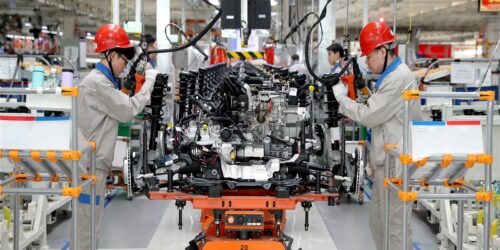Final Research Report – Future of Work and Its Effects on the Canadian Manufacturing Sector

Future of Work and Its Effects on the Canadian Manufacturing Sector
Abstract: Manufacturing sector in Canada is often seen as a cornerstone of the national economy. Currently, Canadian manufacturing firms are facing significant challenges to adapt themselves to every day evolvement of technology and modernisation. Workers in the sector, on the other hand, are having the fear of leaving their jobs to machines and robots every day while advances in modern technology such as industrial automation and machine learning are progressing at a great pace and scale globally (Stuart & Currie & Goodman & Ives & Scott, 2015). While technology is reshaping the fate of the industry, this paper provides an understanding on the global trends in the manufacturing sector where great number of jobs are being made obsolete by the disruptive technologies. It also analyses the current state of the Canadian manufacturing in its struggle to cope with such trends and forces. Lastly, it provides suggestions on what Canadian manufacturing firms should do to be future-ready and how the workers of this sector can survive in the Man vs. Machine War without being made redundant.
Keywords: Fourth Industrial Revolution, New Machine Age, Internet of Things (IoT), Canada, North America, 3D printing, advanced manufacturing, future of work, disruptive technologies, industrial automation, artificial intelligence, digitalisation, robotics, machine learning.
Introduction
According to a research conducted by Forrester Research, one of the most reputable market research company in North America, 25 million jobs will be replaced by automation over the next 10 years, and the most affected ones will fall in the manufacturing industry (2017). Industrial automation and digitalisation are affecting how work is done in the manufacturing sector globally, and Canadian manufacturers and workers, without any exception, are feeling the pressure to keep up with the global forces and trends shaping the future of work significantly.
Background
Manufacturing industry is a primary sector in Canada by contributing to the labour market with 1.7 million jobs and generating more than 10% of Canada’s total GDP which corresponds to approximately $174 billion (Government of Canada, 2019). Plus, manufacturing products constitute 68% of the products exported from Canada worldwide (Government of Canada, 2019). These figures clearly demonstrate that manufacturing is a critical engine for the Canadian economy. However, Canadian manufacturing firms are currently facing significant challenges due to advanced modernisation happening in the global market whereas the workers in the sector are feeling the necessity of getting more modernised and developing new skills every day (Dooner, 2019).
According to Statistics Canada Labour Force Survey, more than 380,000 jobs, mainly manufacturing jobs in Canada have been lost in the last 15 years and although technological advancement is not the only factor causing this trend, it was the main reason thereof (Lamb & Doyle, 2017). It is expected that future of work will be mostly based on machines and automation in Canada too, and the Canadian workers in highly automatable sectors are facing the highest risk to lose their jobs against their non-human colleagues. While the economy and labour market are getting more heavy on technology and light on labour, workers are required to equip themselves with new skills and abilities to survive against the machines and stay employed in the future. According to a study conducted by Ryerson University’s Brookfield Institute, New Machine Age will require Canadians to improve a broad set of technical and soft skills (2017).
Present Trends in the Global Manufacturing Market for the Manufacturing Firms and Workers
As of the Industrial Revolution and over the last two centuries, the manufacturing industry has been absorbing and improving itself with the new developments in technology (Wellener & Dollar & Manolian, 2019). Latest advances in modern technology such as artificial intelligence, virtual reality, robotics, IoT are progressing at an unprecedented pace and scale nowadays, while manufacturing market is the most affected by these advancements.
Today, without any intervention of human workers, industrial robots are carrying, loading, unloading packing and palletizing products; drones are delivering packages; and IoT is enabling companies to provide mass customization. Advanced machines are replacing the need for human workforce performing increasingly complex tasks every day without the need for breaks, holidays, maternity / paternity leaves like us. They enable companies to increase efficiency and productivity, lower costs, and deliver a higher, consistent quality of service. Artificial intelligence allows machines to recognize faces, translate speech, process large amount of data in less than seconds and even mimic human behaviours and functions in real-like manner. Modern AI softwares have already displaced humans in some jobs such as accounting, engineering and law (Meltzer, 2014).
On the other hand, advanced manufacturing is rapidly growing and expanding as the biggest enemy for traditional manufacturing. To understand the disruptive potential of advanced manufacturing, it is enough to look at the course of 3D printing technologies only. Today, 3D printers are able to make almost everything we can imagine, from food to cars, clothes to shoes, drugs to houses, and to even human organs! The number of 3D printers in use are getting doubled every year and annual revenues of 3D printer companies around the world are dramatically increasing in billions which lastly hit $7 billion in 2018 (McCue, 2018).
While the rules of job and the nature of work is changing, the manufacturing industry finds itself in so-called the Fourth Industrial Revolution where disruptive technologies are changing the way we live and work. It is expected that industrial automation will wipe out 25 million jobs over the next 10 years and most of them will be entry-level jobs in the manufacturing field (Forrester Research, 2017). According to a research counducted by McKinsey Global Institute, even if the jobs will not be fully automated, partial automation will affect almost all jobs to smaller or bigger extent (2017). 30 percent of activities in more than half of the occupations around the world are technically automatable which means that we will all need to work with robots, machines or other sort of technologies to greater or lesser degree some day (Manyika, 2017).
Current State of the Canadian Manufacturing Sector Against Disruptive Technologies: Not Promising
Where manufacturing techniques are being more modernised every day, manufacturers and employees in Canadian manufacturing workforce feel the need of becoming more tech-friendly, innovative and highly skilled. In the current situation, Canada does not have enough skilled worker capacity since most of the workers in the manufacturing industry have lack of skills which the technology era requires (Government of Canada, 2019).
According to a survey conducted by Deloitte Canada with 700 business leaders across the country, only 13% of firms have been categorised as highly prepared for the disruptive technologies, 29% of firms are not fully unprepared but are struggling to keep up with the changes, and 35% of firms are not prepared at all, and do not know how to catch the technologies (Stuart et al., 2015). In another research conducted by Canadian Chamber of Commerce, only 6% of manufacturing firms have stated that they adopted a strategy to harness IoT which brings them higher monitoring capacity for their distribution and production processes (2014).
These studies show us that disruption is coming and Canadian firms are not prepared for the upcoming disruption. We believe that adopting new technologies can only be done by innovations; however, Canada’s innovation ranking, according to Global Competitiveness Report issued by World Economic Forum (WEF) is not promising either with 22nd placeamong other global leaders of the world (2015). This ranking falls behind Ireland, Malaysia and Qatar in the list.
All is not lost, however. The good news for Canada is that the country hosts a highly educated knowledge society and it has one of the highest rates of educational attainment among all other countries worldwide. Tech sector in Canada is stronger than before and getting more improved every day too.
What to Do for Canadian Firms to be Future-Ready and Canadian Workers to Survive Against the Machines and Stay Employed
In order for Canada to see disruptive technologies not a challenge, but an opportunity, there are parts to be done by all parties of the society. Canadian government, manufacturing firms, and Canadian workers should do their parts to welcome the disruptive technologies in a confident manner. Especially for the course of economic landscape and labour market, equipping Canadian workforce with the skills needed for future of work requires focused attention.
Luckily, Canadian government is aware that Canada needs to be more competitive if it wants to be a leader in manufacturing and ranked in front on the world stage. Therefore, developing a future-ready manufacturing workforce is one of the objectives listed under The Industrie 2030 Plan by Canadian Manufacturers & Exporters of the Canadian government (Canadian Manufacturers & Exporters, 2017). A survey conducted by Business Council of Canada with 90 Canadian employers shows that companies are investing more in training and development of workforce to improve their workers’ digital skills as well as non-cognitive skills (2016). Also, Canadian government and companies are offering training and investing in tech-driven programs to develop the workers’ essential skills for new needs of the manufacturing world (Government of Canada, 2019). However, Canadian government should develop incentives, policies and a respective roadmap too, in order to push Canada’s manufacturing culture forward to accelerate technology adoption, and creation of digitally skilled human labour.
On the other hand, manufacturing firms should be more focused on innovation to overcome the barriers currently hindering them from adoption of advance technologies. They need to foster awareness of global trends which have the potential to disrupt their business; and invest in new technologies to sustain their position in the global market and compete with their competitors.
As regards the workers in the sector, Canadian workers should upgrade themselves, in order to stay employed, with digital literacy skills which are essential in knowing how to work with machines. Soft skills such as leadership, accountability, interpersonal communication, problem-solving will also help them to survive in the machine world without being made redundant. It is obvious from today that, in not-so-distant future, human labour will have no chance to compete against machines, in particular on frequent, high-volume tasks. However, machines cannot defeat humans in novel situations. Therefore, workers need to train themselves in novel situations and understand that they do not need to beat the machines, all they need is to learn how to work “with” them.
Future Research
In relevance with the limitations of this research, suggestion for a future research include the following point:
- This paper analysed the current state of manufacturing workforce of Canada against the future of work trends by assessing overall labour in the market as a whole. Future research can conduct studies on different levels and/or categories of workforce separately, in order to analyse whether the young workers and seniors, or males and females, share the same state with respect to welcoming the disruptive technologies, and/or they feel ready in the same manner against what future of work brings. This can need conducting interviews with millennial and non-millennial, and male and female workers.
Conclusion
For manufacturing to remain a pioneer sector in Canada and continue to be a leading contributor to the economy, there is a huge way to go for the players of Canadian manufacturing industry. All parties and stakeholders constituting the sector needs to be aware of the fact that rather than racing against the machines, all needed to be done is to learn racing “with” the machines (Bernstein & Raman, 2015), and innovation is key to success in the current age of disruption in order to absorb and adopt the advanced manufacturing trends and forces.
References
Bernstein, A. & Raman, A. (2015) The Great Decoupling: An Interview with Erik Brynjolfsson and Andrew McAfee. Harvard Business Review. Retrieved October 6, 2019, from https://hbr.org/2015/06/the-great-decoupling
Business Council of Canada (2016). Developing Canada’s future workforce: a survey of large private-sector employers. Retrieved October 6, 2019, from https://thebusinesscouncil.ca/wp-content/uploads/2016/03/Developing-Canadas-Future-Workforce.pdf
Canadian Chamber of Commerce (2014). Manufacturing Innovation: Driving Canada’s Biggest Sector Through Disruptive Technologies. Retrieved October 6, 2019, from http://www.chamber.ca/media/blog/141712-manufacturing-innovation-driving-canadas-biggest-sector-through-disruptive-technologies/
Canadian Manufacturers & Exporters (2017). The Future of the Manufacturing. Retrieved October 6, 2019, from https://www.industrie2030.ca/download.php?id=40
Dooner, A. (n.d.). The Future of Canadian Manufacturing: Learning from Leading Firms. Retrieved September 22, 2019, from https://www.ivey.uwo.ca/cmsmedia/1066973/2-fom-globalcontext.pdf
Forrester Research. (2017). Forrester Predicts Automation Will Displace 24.7 Million Jobs and Add 14.9 Million Jobs By 2027. Retrieved September 14, 2019, from https://go.forrester.com/press-newsroom/forrester-predicts-automation-will-displace-24-7-million-jobs-and-add-14-9-million-jobs-by-2027/
Government of Canada. (2019). Manufacturing sector gateway. Retrieved October 12, 2019, from https://www.ic.gc.ca/eic/site/mfg-fab.nsf/eng/home
Lamb, C. & Doyle, S. (2017). Future-proof: Preparing young Canadians for the future of work. Retrieved September 22, 2019, from https://brookfieldinstitute.ca/wp-content/uploads/FINAL-FP-report-Onlinev3.pdf
Manyika, J. & Chui, M. & Miremadi, M. & Bughin, J. & George, K. & Willmott, P. & Dewhurst, M. (2017) Harnessing automation for a future that works. McKinsey. Retrieved October 5, 2019, from https://www.mckinsey.com/featured-insights/digital-disruption/harnessing-automation-for-a-future-that-works
Manyika, J. (2017) Technology, jobs, and the future of work. McKinsey. Retrieved October 5, 2019, from https://www.mckinsey.com/featured-insights/employment-and-growth/technology-jobs-and-the-future-of-work
Mccue, T. (2018) Wohlers Report 2018: 3D Printer Industry Tops $7 Billion. Forbes. Retrieved October 6, 2019, from https://www.forbes.com/sites/tjmccue/2018/06/04/wohlers-report-2018-3d-printer-industry-rises-21-percent-to-over-7-billion/
Meltzer, T. (2014). Robot doctors, online lawyers and automated architects: the future of the professions?. The Guardian. Retrieved October 5, 2019, from http://www.theguardian.com/technology/2014/jun/15/robot-doctors-online-lawyers-automated-architects-futureprofessions-jobs-technology
Stuart, T. & Currie, B. & Goodman, J. & Ives, G. & Scott, L. W. (2015). Age of disruption – Are Canadian firms prepared?. Deloitte. Retrieved October 5, 2019, from https://www.corpgov.deloitte.ca/en-ca/Documents/StrategyAndRisk/AgeOfDisruption_042015.pdf
Wellener, P. & Dollar, B., & Manolian, H. A. (2019) The future of work in manufacturing – What will jobs look like in the digital era?. Deloitte. Retrieved October 5, 2019, from https://www2.deloitte.com/us/en/insights/industry/manufacturing/future-of-work-manufacturing-jobs-in-digital-era.html
World Economic Forum (2015). The Global Competitiveness Report. Retrieved October 6, 2019, from http://reports.weforum.org/global-competitiveness-report-2014-2015/?doing_wp_cron=1570406413.3742709159851074218750





